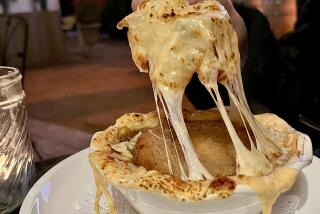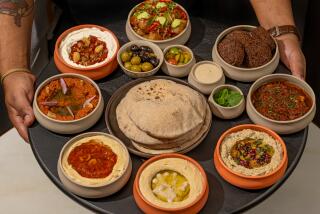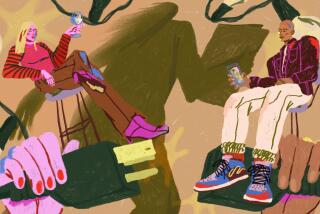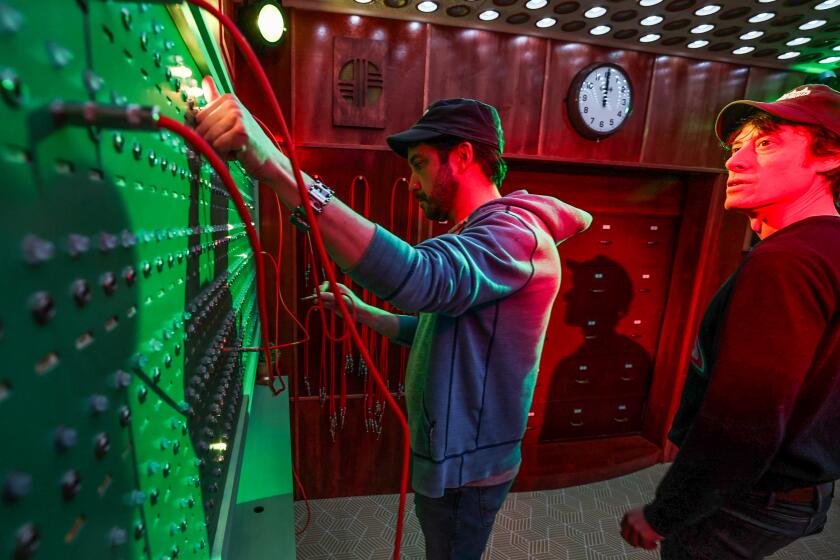A taste of Lyon, France
Food? Art? History? It’s all here in this slightly quirky city
On that famous restaurant byway, Rue Merciere, servers were putting chairs on tabletops and sweeping up crumbs.
I had arrived in this gourmand paradise far too late for dinner.
Feeling hungry and desperate, I headed for a neon sign that proclaimed, “Pizzas Rock.” At first glance, the place reminded me of Edward Hopper’s “Nighthawks” diner, albeit with a French twist. A plump man sat sideways at a narrow counter against one wall, nursing an espresso and smoking a cigarette. Two other men, much younger, fiddled with their pizza oven. Overhead lights glared, and a boom box played vintage rock ‘n’ roll.
I speak some French, but fatigue blocked out huge sections of vocabulary. “Parlez vous Anglais?” “Un peu.” With a few added smiles and gestures, that got us started.
I managed to convey my desire for a calzone and a bottle of Cellier des Dauphins Cote du Rhone 2004. While one young man cooked, the other peppered me with questions.
“You are English?”
“No, American.”
“Ohhh! California!”
The cook let the oven do its work and joined us. Pointing at his partner, he said, “He wants to go to the United States very bad.”
“California,” said the counterman. “Where it’s warm.”
“I’m from Chicago. Where it’s cold,” I said.
The cook then gestured toward the boom box, perched on a narrow stairway that apparently led to a dining area on the floor above. “Do you know what that is playing?” he asked me.
I shrugged. Back in the ‘60s and ‘70s I was into bebop. Still am. The box was pumping out some kind of mordant-hippie refrain.
“It’s the Doors!” the cook said. His thumb jerked toward the partner again. “He is Jim Morrison’s biggest fan. He is vice president of the Jim Morrison Fan Club.”
I asked the vice president of the Jim Morrison Fan Club to open my Cote du Rhone, but he couldn’t find a corkscrew. The man with the espresso did have one (I thought, how French is that?). He handed it over, told the kid to keep it. “Ohhh, merci!” Smiles all around.
I walked to Hotel des Artistes and ate dinner in my room.
My first hours in Lyon may have been inauspicious in a gastronomic sense, but they were just as satisfying as a dish of raviolis d’escargots: a hot snack, a decent wine and the honor of meeting a high official of the Jim Morrison Fan Club. Lyon couldn’t have said bienvenue and bon appetit any better.
As French cities go, Lyon seems slightly quirky, a bit less formal than, say, Paris or Nice -- except when certain high-end restaurants require it.
And, of course, the bouchons here won’t let you go hungry. A bouchon is a casual cafe with menus (or slate boards) heavy on local specialties, literally heavy: fried stomach, pork sausage, veal sausage, pig-intestine sausage, sheep trotters, calf brain ...
A few bouchons operate along Rue Merciere, but brasseries and restaurants with a little more tourist appeal predominate. On another evening, I could tell I was in a bouchon -- this one called Les Enfants Terrible -- when I blindly pointed at something on the menu and the server shook her head firmly and said non. “It is made from stomach and blood,” she warned. I thanked her and opted for the salade nicoise.
The morning after my arrival, a Thursday, I prepared to explore the town. Unfortunately, my timing was off again. “It is a bank holiday,” explained the hotel desk clerk as I handed over a room key attached to a tasseled gilt object that must have weighed close to a pound.
A bank holiday in France means that nearly everything closes -- shops, some restaurants, a smattering of attractions and, naturally, the tourism office. So I simply let myself get caught up in the excitement of Lyon on spring break.
At Place Bellecour, a hot-air balloon hovered near the equestrian statue of Louis XIV, while runners competing in some sort of race trotted through an obstacle course and loudspeakers blared Franco-pop hits. A carnival spirit had begun to build. I would have joined the party, but Lyon offers so much to see.
It was a good day to just stroll around and soak up the atmosphere, admire the beaux arts buildings downtown and lose myself in the little medieval alleyways called traboules in Vieux Lyon. The city blankets all sides of the Rhone and Saone rivers. Its handsome central district sits on the peninsula formed by the rivers’ convergence.
Like most visitors, I found plenty of attractions on the peninsula -- Presque Isle -- and in the hilly area west of the Saone, which includes St. John the Baptist Cathedral, Notre Dame Basilica, Roman ruins and the quaint, medieval-Renaissance part of town.
Since World War II, the city has been repaired, restored and rebuilt so that the charm quotient remains high. And yet Lyon doesn’t lack for monumental, imposing works of sculpture and masonry. The hillside Notre Dame de Fourviere Basilica, for example, demands attention not only for its regal presence on the banks of the Saone, but for the impossibly intricate embellishments across its facade.
It’s likely that sculptor Frederic-Auguste Bartholdi wanted to provoke overwhelmed gasps with his impressive fountain on Place des Terreaux. Four muscular horses, snorting steam, frantically pull a chariot, as if they intend to gallop across the square. The horses symbolize French rivers plunging toward the sea, and I did gasp when I came upon them, just as I gasped at my first glimpse of Bartholdi’s Statue of Liberty.
Place des Terreaux serves to set off the ornate Hotel de Ville (city hall) and the Museum of Fine Arts, another 19th-century confection. All across the open space in front of those delightful structures, tiny fountains gurgle and occasionally splash an inattentive pedestrian.
Inside, the museum represents European artistry extremely well. Startling images pop out from the walls of otherwise serene galleries. Its collection of impressionists is said to be the largest outside of the Musee d’Orsay in Paris. The museum courtyard -- a quiet space with sun-dappled statuary -- allows people to retreat from the bustle of Place des Terreaux and escape from the skateboarders scuffing down the nearby Opera House steps.
From the museum, I walked across Place des Terreaux, past al fresco cafes and up a hill that led to the Atelier de Soierie, a reminder that Lyon once marched in the vanguard of silk weaving and the manufacture of other fabrics. The atelier faced a courtyard crowded with visitors waiting to enter. Inside, another large group watched workers do their silk-screen magic at long tables, making flowers appear on the white cloth.
Tall houses in the Croix Rousse section on the northern part of central Lyon indicate they once were built to accommodate the tall looms required by the trade. Factories take up most of the weaving chores now, but the houses, once designed for practical reasons, now look rather grand.
A few of the newer buildings near the Saone demand attention, too, because artists covered them with murals. One formerly blank wall in a neighborhood of booksellers has become a giant set of shelves brimming with all sorts of bound volumes. Other murals honor pioneers of the fabric and printing trades, plus prominent scientists, athletes, artists and government officials.
A facade at an intersection close to the river resembled, from a distance, a comic-book page. Each panel held a life-size trompe l’oeil portrait of a historical figure -- for example Joseph-Marie Jacquard, the fabric innovator; Giovanni da Verrazzano, the 16th-century explorer who discovered New York; and master chef Paul Bocuse, the Lyon-based star of French cuisine. Some 100 walls in Lyon and scores more in other parts of Europe have been painted in this manner by members of the artists’ collective Cite de la Creation.
Lyon’s buildings really shine each Dec. 8, during the spectacular Festival of Lights, when every window holds a candle honoring the Virgin Mary.
One evening, I took a taxi to the village of Collonges, beside the Saone River, for a meal at Bocuse’s Michelin three-star flagship. His monument to gastronomy is an ornate red and green palace trimmed in gold. Without the big, neon PAUL BOCUSE sign on top, it might be mistaken for a gaudy Chinese restaurant. I could tell that Cite de la Creation artists had been hard at work on hundreds of exterior details. A painting of the chef himself peered down from an upstairs faux “window.” On a wall in the courtyard, paintings depicted a history of French cuisine. There were the mothers of Lyon who nurtured their families and bouchon patrons with their kitchen artistry, thus beginning the city’s fine-dining tradition. Other paintings honored the great chefs of yore and such modern popularizers of French cuisine as James Beard and Julia Child.
Inside, of course, formality trumps flash. It’s a world of bowing maitre d’s, crisp tablecloths, amber light and subtle but delicious aromas. I understood that I’d be served French gourmet food in the traditional manner, nothing too nouveau. Bocuse does oversee fashion-forward eateries in other parts of town, but this place mostly adheres to the classics.
So, for me, it would be the amuse bouche of cold, salty broth covered with crème fraich, chives and shaved carrot, followed by duck foie gras and a superb rack of lamb. Enhancing the entree was a half bottle of a 1997 Chateau Clarke medoc, a wine that’s robust, chewy, powerful and fruity, as advertised.
Almost everyone in the place treated the meal as a special occasion. Italian, English, French and German conversations all came out sounding equally excited.
As busboys cleared the dessert plates, the legendary Paul Bocuse himself circulated among the patrons. He accepted praise with a tight little smile and posed for pictures in his white jacket and toque. Aside from a slight stoop, he looked precisely like the Bocuse in the mural that overlooks the parking lot.
That was all very pleasant and impressive, but after dinner I felt eager to leave those rural surroundings and return to the city.
Judging by what I had seen up till then, the streets in town offered endless possibilities. One day, I rode the town funicular up to its last stop on Fourviere Hill and explored the Roman ruins remaining from more than 2,000 years ago, when the city, then called Lugdunum, became the capital of the Gauls and a major crossroads for trade, religion and the military.
The funicular ride down into Vieux Lyon, the medieval and Renaissance sector, is like a ride through the centuries -- the 15th, when Lyon became Europe’s leading publishing and textiles center, and on to the 18th and the advent of its rise to the continent’s silk-weaving capital.
From the Notre Dame Basilica terrace, the city spreads eastward to the horizon, a mighty metropolitan area of some 2 million people, where big things happened a long time ago and still do.
The basic unit of electric current was named for Lyon physicist Andre-Marie Ampere, and the city still is a leader in scientific research, industry, commerce and banking.
Nor does Lyon take a backseat when it comes to the arts. Among the narrow buildings of Vieux Lyon, the fascinating International Miniature Museum has room after room of intricately detailed displays: restaurant interiors, classrooms, music rooms, automobiles. If photographed without context, any of them would fool the eye as easily as the big wall murals across the Saone. Lyon is famous for its puppet museum and theater, too, which is easy to spot because of those clusters of children watching the amusing window displays.
I found the Lumiere Museum in a quiet neighborhood a few subway stops from the central city. Auguste and Louis Lumiere created the first motion picture in 1895, and the museum not only offers a clear window into life in the early days of cinematography, but also a look at the way an upper-class family lived in the late 19th century.
That’s because the museum occupies the Lumieres’ boyhood home. Their gadgets, inventions and cameras have been placed throughout the rooms as if the inventors had just been called away from their experiments -- perhaps to lunch.
On a Sunday close to lunchtime, I went looking for Relais Gourmand Pierre Orsi on the Rhone’s left bank. I assumed it would be closed, but I wanted to take a look at the Michelin one-star restaurant, because Pierre Orsi worked for a time in Chicago -- at the old Maxim’s on Astor Street and the 95th atop the Hancock.
I found the old brick building on Place Kleber looking polished, dressed up and somewhat out of place on a boulevard of pharmacies and fashion boutiques. Back in the 18th century, it had a more appropriate context -- acres of farmland. I peeked through the glass pane on the door and heard voices; I saw shadowy figures moving around.
A well-dressed man opened the door and invited me in. I had just finished a long walk in the spring heat, all the way from the hotel. My clothes were rumpled, but the greeter and other members of the staff treated me like royalty, despite my appearance.
The dining room couldn’t have been more formal -- heavy pink and green plaid drapes, big wooden cabinets, polished silver, pink walls, round tables, dramatic lighting.
All of the other diners were couples, whispering in deference to the setting and wearing their Sunday best.
It’s hard to relax when dining alone in that sort of atmosphere, but the food soon required full attention. It started with a confit of shrimp, pureed potato and shallots. My trio-of-salads plate arrived, each mound of vegetables topped with a different kind of seafood -- red snapper, langoustines, salmon. Delicate flavors. A wonderful light lunch. A $50 tab.
Afterward, the maitre d’, who introduced himself as Pascal Nabat, walked with me to the door. I told him I was in Lyon to write about the city and I was sorry Pierre Orsi was taking the day off, because it would have been a pleasure to meet him.
Nabat and I exchanged cards. Turned out we had mutual friends elsewhere in France and that he knew Chicago’s restaurant scene quite well.
“We know Charlie Trotter, chef Joho’s Everest, Le Francais in Wheeling,” Nabat said, “all excellent.”
I wondered if residents of Lyon suffered any kind of inferiority complex, vis-a-vis Paris.
“No, Lyon is very good,” he insisted. “It’s not so big, but big enough. In a few minutes, you can be in the countryside. Or if you want to ski, the Alps aren’t far away. And it’s two hours to Paris on the TGV [the fast train].”
On this trip to France, I felt no urge to work Paris into my itinerary, as I usually do. Lyon proved to be more than sufficient. It does the country proud.
Getting around:
For the sake of convenience and potentially big savings, I recommend the Lyon City Card. It’s a pass for everything in the public transportation system -- buses, subway and the funicular that climbs up to Fourviere. But that’s not all. The card is also good for free admission to a slew of museums, some theatrical performances and concerts -- and a discount of at least 10 percent almost everywhere. For example, take 10 percent off the seven-euro (about $9.20) basic fare for a Cyclopolitan, Lyon’s unique pedicab with an electric-motor boost. That’s getting around in style. A three-day card costs 38 euros, or about $50 at a rate of $1.31 to the euro, and can be purchased at the tourism office or over the Internet (see below).
Sleeping there:
I made Hotel des Artistes (8 Rue Gaspard-Andre; 011-33- 04-78-42-04-88; hoteldesartistes.fr) my headquarters, and it served admirably. The lobby with its vivid colors and the breakfast room’s Jean Cocteau-style mural justify the “Artistes.” My room, however, was plain -- but clean and comfortable. Doubles from $118 to $157. Breakfast $12.
A long list of accommodations, from backpacker to one-star to four-star is available from the official tourism office.
Dining there:
My two ventures into haute cuisine are described in the main story. Paul Bocuse’s main restaurant, L’Auberge du Pont de Collonges (40 Quai de la Plage; 011-04-72-42-90-90; bocuse.com), is the stuff of pilgrimages. Entrees from $55. Relais Gourmand Pierre Orsi (3 Place Kleber; 011-04-78-89-57-68; pierreorsi.com) also merits a special trip. Entrees about $59.
Along and near the famous Rue Merciere, I had excellent meals. It’s an area to browse and see what looks good before settling in.
Information:
Lyon Convention and Visitors Bureau, Place Bellecour; 011-33-04-78-42-04-32; en.lyon-france.com.
More to Read
Sign up for The Wild
We’ll help you find the best places to hike, bike and run, as well as the perfect silent spots for meditation and yoga.
You may occasionally receive promotional content from the Los Angeles Times.






